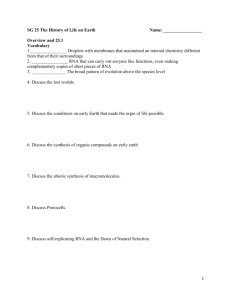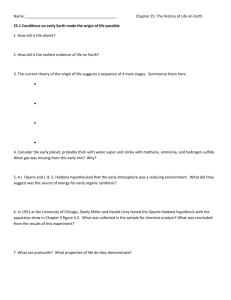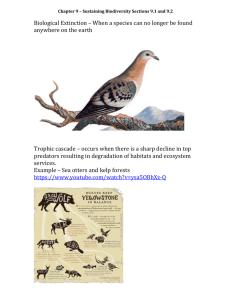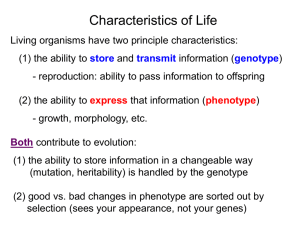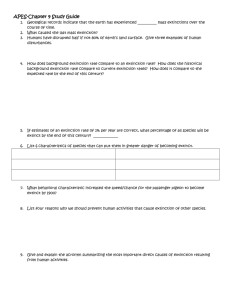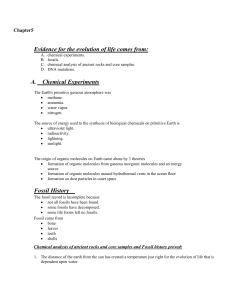Chapter 25
advertisement
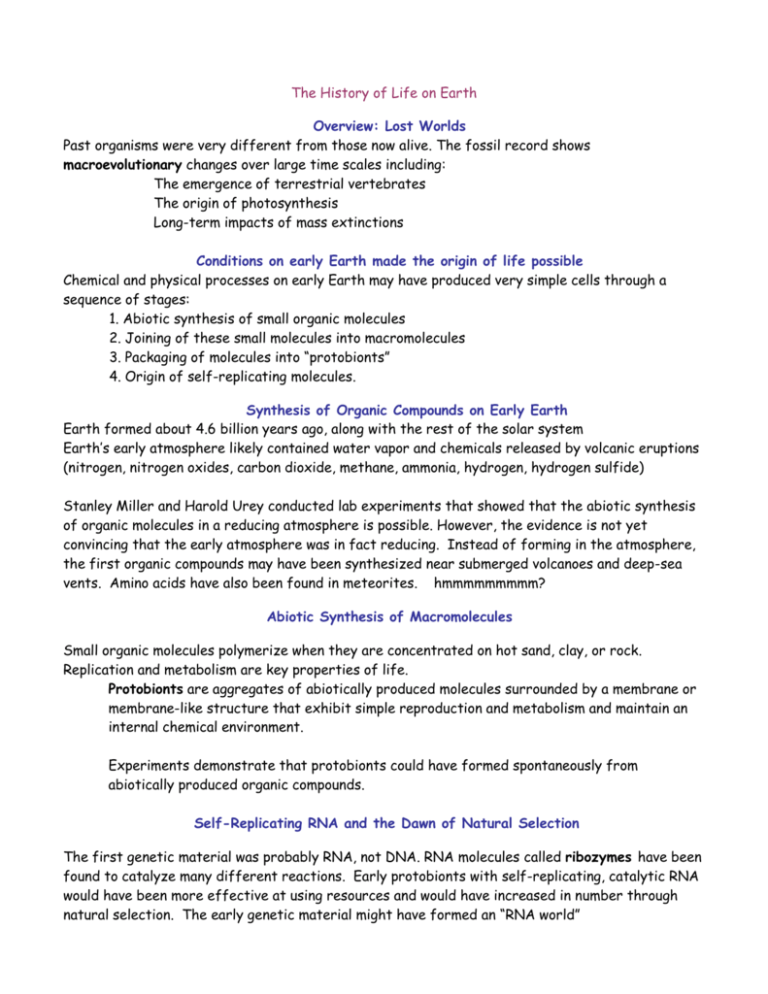
Chapter 25 The History of Life on Earth Overview: Lost Worlds Past organisms were very different from those now alive. The fossil record shows macroevolutionary changes over large time scales including: The emergence of terrestrial vertebrates The origin of photosynthesis Long-term impacts of mass extinctions Conditions on early Earth made the origin of life possible Chemical and physical processes on early Earth may have produced very simple cells through a sequence of stages: 1. Abiotic synthesis of small organic molecules 2. Joining of these small molecules into macromolecules 3. Packaging of molecules into “protobionts” 4. Origin of self-replicating molecules. Synthesis of Organic Compounds on Early Earth Earth formed about 4.6 billion years ago, along with the rest of the solar system Earth’s early atmosphere likely contained water vapor and chemicals released by volcanic eruptions (nitrogen, nitrogen oxides, carbon dioxide, methane, ammonia, hydrogen, hydrogen sulfide) Stanley Miller and Harold Urey conducted lab experiments that showed that the abiotic synthesis of organic molecules in a reducing atmosphere is possible. However, the evidence is not yet convincing that the early atmosphere was in fact reducing. Instead of forming in the atmosphere, the first organic compounds may have been synthesized near submerged volcanoes and deep-sea vents. Amino acids have also been found in meteorites. hmmmmmmmmm? Abiotic Synthesis of Macromolecules Small organic molecules polymerize when they are concentrated on hot sand, clay, or rock. Replication and metabolism are key properties of life. Protobionts are aggregates of abiotically produced molecules surrounded by a membrane or membrane-like structure that exhibit simple reproduction and metabolism and maintain an internal chemical environment. Experiments demonstrate that protobionts could have formed spontaneously from abiotically produced organic compounds. Self-Replicating RNA and the Dawn of Natural Selection The first genetic material was probably RNA, not DNA. RNA molecules called ribozymes have been found to catalyze many different reactions. Early protobionts with self-replicating, catalytic RNA would have been more effective at using resources and would have increased in number through natural selection. The early genetic material might have formed an “RNA world” The fossil record documents the history of life Sedimentary rocks are deposited into layers called strata and are the richest source of fossils Few individuals have fossilized, and even fewer have been discovered. The fossil record is biased in favor of species that existed for a long time, were abundant and widespread, and had hard parts. How Rocks and Fossils Are Dated Sedimentary strata reveal the relative ages of fossils. The absolute ages of fossils can be determined by radiometric dating. A “parent” isotope decays to a “daughter” isotope at a constant rate. Each isotope has a known half-life, the time required for half the parent isotope to decay. Radiocarbon dating can be used to date fossils up to 75,000 years old. For older fossils, some isotopes can be used to date sedimentary rock layers above and below the fossil. The Origin of New Groups of Organisms Mammals belong to the group of animals called tetrapods. The evolution of unique mammalian features through gradual modifications can be traced from ancestral synapsids through the present Key events in life’s history include the origins of single-celled and multicelled organisms and the colonization of land. The geologic record is divided into the Archaean, the Proterozoic, and the Phanerozoic eons The Phanerozoic encompasses multicellular eukaryotic life The Phanerozoic is divided into three eras: Paleozoic, Mesozoic, and Cenozoic The First Single-Celled Organisms The oldest known fossils are stromatolites, rock-like structures composed of many layers of bacteria and sediment. They date back 3.5 billion years ago. Prokaryotes were Earth’s sole inhabitants from 3.5 to about 2.1 billion years ago Photosynthesis and the Oxygen Revolution Most atmospheric oxygen (O2) is of biological origin. The source of O2 was likely photosynthetic bacteria similar to modern cyanobacteria. By about 2.7 billion years ago, O2 began accumulating in the atmosphere and rusting iron-rich terrestrial rocks. This “oxygen revolution” occurred about 2.7 to 2.2 billion years ago. The First Eukaryotes The oldest fossils of eukaryotic cells date back 2.1 billion years The hypothesis of endosymbiosis proposes that mitochondria and plastids (chloroplasts and related organelles) were formerly small prokaryotes living within larger host cells. An endosymbiont is a cell that lives within a host cell. The prokaryotic ancestors of mitochondria and plastids probably gained entry to the host cell as undigested prey or internal parasites.In the process of becoming more interdependent, the host and endosymbionts would have become a single organism. Key evidence supporting an endosymbiotic origin of mitochondria and plastids: Similarities in inner membrane structures and functions Division is similar in these organelles and some prokaryotes These organelles transcribe and translate their own DNA Their ribosomes are more similar to prokaryotic than eukaryotic ribosomes The Origin of Multicellularity The evolution of eukaryotic cells allowed for a greater range of unicellular forms A second wave of diversification occurred when multicellularity evolved and gave rise to algae, plants, fungi, and animals. The Earliest Multicellular Eukaryotes Comparisons of DNA sequences date the common ancestor of multicellular eukaryotes to 1.5 billion years ago. The oldest known fossils of multicellular eukaryotes are of small algae that lived about 1.2 billion years ago The “snowball Earth” hypothesis suggests that periods of extreme glaciation confined life to the equatorial region or deep-sea vents from 750 to 580 million years ago. The Cambrian Explosion The Cambrian explosion refers to the sudden appearance of fossils resembling modern phyla in the Cambrian period (535 to 525 million years ago). The Cambrian explosion provides the first evidence of predator-prey interactions. DNA analyses suggest that many animal phyla diverged before the Cambrian explosion, perhaps as early as 700 million to 1 billion years ago. Fossils in China provide evidence of modern animal phyla tens of millions of years before the Cambrian explosion. The Colonization of Land Fungi, plants, and animals began to colonize land about 500 million years ago. Plants and fungi likely colonized land together by 420 million years ago. Arthropods and tetrapods are the most widespread and diverse land animals. Tetrapods evolved from lobe-finned fishes around 365 million years ago. Continental Drift At three points in time, the land masses of Earth have formed a supercontinent: 1.1 billion, 600 million, and 250 million years ago . Earth’s continents move slowly over the underlying hot mantle through the process of continental drift. Oceanic and continental plates can collide, separate, or slide past each other. Interactions between plates cause the formation of mountains and islands, and earthquakes. Consequences of Continental Drift Formation of the supercontinent Pangaea about 250 million years ago had many effects A reduction in shallow water habitat A colder and drier climate inland Changes in climate as continents moved toward and away from the poles Changes in ocean circulation patterns leading to global cooling Mass Extinctions The fossil record shows that most species that have ever lived are now extinct. At times, the rate of extinction has increased dramatically and caused a mass extinction The “Big Five” Mass Extinction Events In each of the five mass extinction events, more than 50% of Earth’s species became extinct. 5) Ordovician–Silurian extinction event (450–440 Ma ) 4) Late Devonian extinction: (375–360 Ma) 3) Permian extinction (251 Ma) This mass extinction occurred in less than 5 million years and caused the extinction of about 96% of marine animal species.This event might have been caused by volcanism, which lead to global warming, and a decrease in oceanic oxygen. 2) The Triassic–Jurassic extinction (201.3 Ma) 1) Cretaceous mass extinction (65.5 Ma) Organisms that went extinct include about half of all marine species and many terrestrial plants and animals, including most dinosaurs. The presence of iridium in sedimentary rocks suggests a meteorite impact about 65 million years ago. Is a Sixth Mass Extinction Under Way? Scientists estimate that the current rate of extinction is 100 to 1,000 times the typical background rate. Data suggest that a sixth human-caused mass extinction is likely to occur unless dramatic action is taken. Consequences of Mass Extinctions Mass extinction can alter ecological communities and the niches available to organisms It can take from 5 to 100 million years for diversity to recover following a mass extinction Mass extinction can pave the way for adaptive radiations Adaptive Radiations Adaptive radiation is the evolution of diversely adapted species from a common ancestor upon introduction to new environmental opportunities Changes in Spatial Pattern Substantial evolutionary change can result from alterations in genes that control the placement and organization of body parts. Homeotic genes determine such basic features as where wings and legs will develop on a bird or how a flower’s parts are arranged. Hox genes are a class of homeotic genes that provide positional information during development If Hox genes are expressed in the wrong location, body parts can be produced in the wrong location. For example, in crustaceans, a swimming appendage can be produced instead of a feeding appendage. Evolution of vertebrates from invertebrate animals was associated with alterations in Hox genes. Two duplications of Hox genes have occurred in the vertebrate lineage These duplications may have been important in the evolution of new vertebrate characteristics Evolution is not goal oriented Evolution is like tinkering—it is a process in which new forms arise by the slight modification of existing forms. Evolutionary Novelties Most novel biological structures evolve in many stages from previously existing structures Complex eyes have evolved from simple photosensitive cells independently many times. Exaptations are structures that evolve in one context but become co-opted for a different function. Natural selection can only improve a structure in the context of its current utility Evolutionary Trends Extracting a single evolutionary progression from the fossil record can be misleading Apparent trends should be examined in a broader context. According to the species selection model, trends may result when species with certain characteristics endure longer and speciate more often than those with other characteristics. The appearance of an evolutionary trend does not imply that there is some intrinsic drive toward a particular phenotype You should now be able to: Define radiometric dating, serial endosymbiosis, Pangaea, snowball Earth, exaptation, heterochrony, and paedomorphosis Describe the contributions made by Miller, and Urey toward understanding the origin of organic molecules Explain why RNA, not DNA, was likely the first genetic material Describe and suggest evidence for the major events in the history of life on Earth from Earth’s origin to 2 billion years ago Briefly describe the Cambrian explosion. Explain how continental drift led to Australia’s unique flora and fauna Describe the mass extinctions that ended the Permian and Cretaceous periods Explain the function of Hox genes
